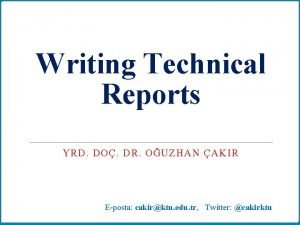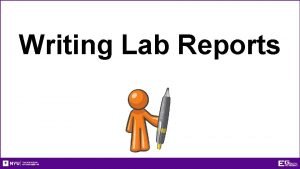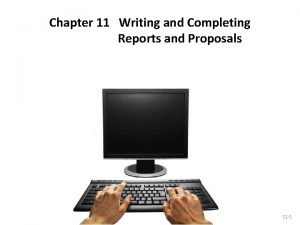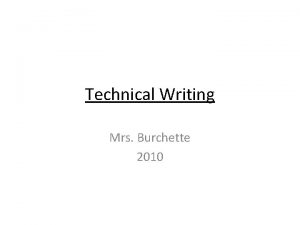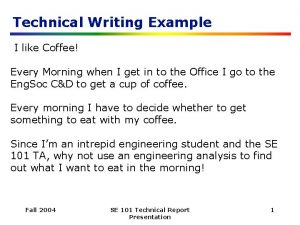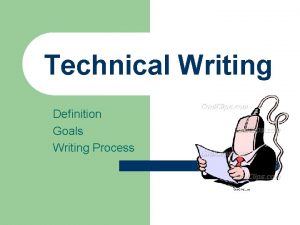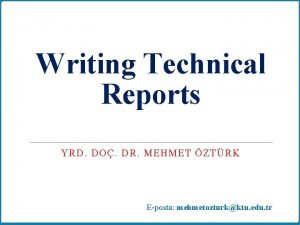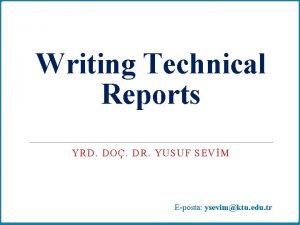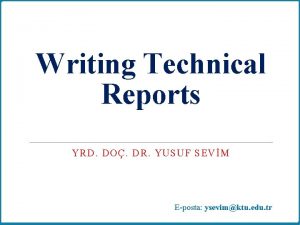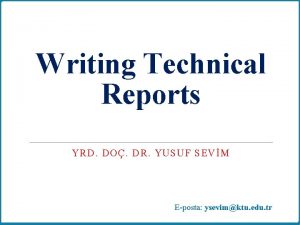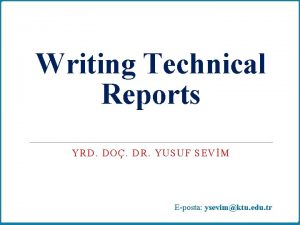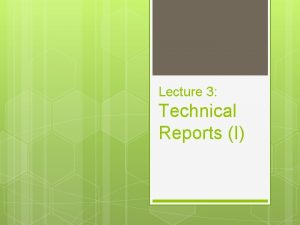Writing Technical Reports YRD DO DR MEHMET ZTRK











- Slides: 11

Writing Technical Reports YRD. DOÇ. DR. MEHMET ÖZTÜRK E-posta: mehmetozturk@ktu. edu. tr 1

5 Format 5. 6 Visual information • Aside from text, other modes of communication are often used in reports such as illustrations (or figures) including graphs and photographs and, tables of information. • A graph can be used to good effect to illustrate the nature of a trend or relationship between two variables. 2/11

5 Format 5. 6 Visual information • Figures include a range of illustrations such as graphs, technical drawings, sketches, photographs, maps and plans. • Figures are intended to aid in understanding of a concept discussed in the report. • Graphs are a means of displaying measured quantities and can be particularly useful in communication by creating a visual representation of data. 3/11

5 Format 5. 6 Visual information • Tables are a means of presenting data arranged in columns and rows. • The data might be quantitative, qualitative or some combination of both. • They are used when the exact values of the data are important to the discussion. • When designing visual information, ensure sufficient labels and headings are provided. • Figures and tables should be self-contained in terms of highlighting a particular point for the reader’s attention. 4/11

5 Format 5. 6 Visual information • Figures and tables should be included in a report only if they assist in the communication process. • Hence; each figure, table and equation contained in a report must be referred to by its caption number in the text of the report. • Further, it should explained in the text of the report, the particular points that are intended to be illustrated in the figure or table; • that is; explicitly tell the reader what to look for in the table or figure. 5/11

5 Format 5. 6 Visual information • The caption for a figure or table has two parts: • a number, and • a short description. • It is customary to consecutively number all figures and tables in the order that they are placed in the report (eg. Table 1, Table 2 and, Figure 1, Figure 2 etc). • When referring to a figure, table or equation, it is sufficient to refer to the respective figure/table number. • Do NOT use expressions such as “refer to the figure above…” or “as the following figure shows…” 6/11

5 Format 5. 6 Visual information • The words figure, table and equation should be treated as proper nouns when used in the text of the report as well as in the caption and should not be abbreviated, • for example “. . . as shown in Figure 1. ” • As a general rule, the captions for figures and tables are centred on the page such that: • captions for tables are placed above the table as for example shown in Table 8; and • captions for figures are placed below the figure as for example shown in Figure 1. 7/11

5 Format 5. 6 Visual information • Needless to say, it is always desirable to place the figure or table in close proximity to and preferably after the paragraph where it is has been referred to in the text of the report. • As with values and units, it is good practice to insert a non-breaking space between the Word Figure (or Table) and the caption sequence number to ensure both appear on the same line. • The report must acknowledge any figure or table that is copied or adapted from another work. Otherwise it is considered as plagiarism and possibly a breach of copyright. • Use the author-date system to include the reference citation in the label caption and provide the full publication details in the References section of the report. 8/11

5 Format 5. 6 Visual information • Values are shown on both axes. The upper and lower limits of the range for each axis were selected to more clearly show the nature of the relationship. • A sufficient number of tick marks have been placed along each axis to indicate the scale without unduly cluttering the axis. • A line of best fit has been added to show the nature of the underlying relationship rather than a line drawn from point-to-point. • A label has been placed against each line to identify and distinguish the particular variable. 9/11

5 Format 5. 6 Visual information • As multiple measurements were made at each level of the independent variable the average value of the dependent variable is shown together with the corresponding range indicating the standard deviation. • Note this is no figure title is included within the plot/chart area (which is included by default when using MS Excel) as the figure caption already serves this purpose. 10/11

5 Format 5. 7 Plans and drawings • In the case of plans, maps, charts and technical drawings of equipment there is an additional set of requirements. • These types of illustrations should include a scale, legend for the different symbols used in the illustration and a North direction indicator. 11/11
 Difference between formal and informal reports
Difference between formal and informal reports Dr_ouzhan
Dr_ouzhan Similarities of academic writing and technical writing
Similarities of academic writing and technical writing Purpose of writing reports
Purpose of writing reports Writing and completing reports and proposals
Writing and completing reports and proposals Prefatory elements
Prefatory elements Laporan singkat adalah
Laporan singkat adalah Technical writing quiz
Technical writing quiz Vocabulary of technical writing
Vocabulary of technical writing Characteristics of technical writing
Characteristics of technical writing Example of technical writing
Example of technical writing Technical writing definition
Technical writing definition

